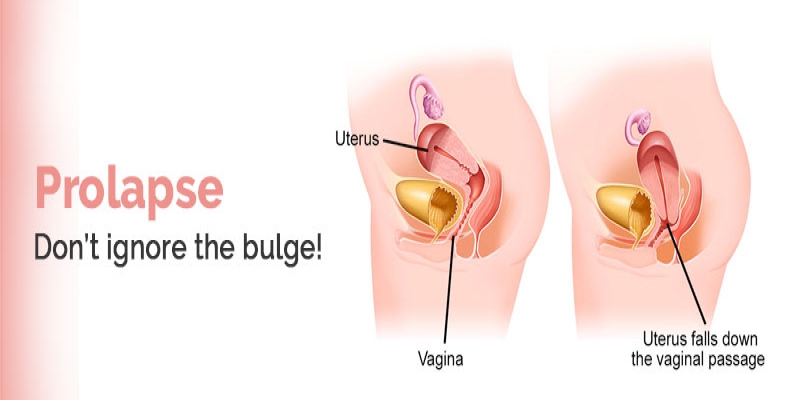Prolapse – Don’t Ignore The Bulge !
2020-01-13 / RG STONE HOSPITAL / Exercise

Pelvic floor disorders happen when pelvic organs supporting muscles become weak.
This can be of various types including urinary incontinence (involuntary leakage of urine), fecal incontinence (involuntary passage of stool), or pelvic organ prolapse (urinary bladder, bowel, or uterus drops into the vagina and cause a bulge).
One in every three women get impacted by this disorder once in their lifetime but seldom talks about it.
Men also get affected, but women are more prone as their pelvic floor undergoes a lot of strain.
There are no age limitations to the development of this disorder.
The causes to be blamed are genetic causes, lifestyle, pregnancy, childbirth, overweight, age, and many more.
The symptoms of prolapse include a feeling of a lump coming out of the vaginal orifice, pressure in the urinary bladder region, leakage of urine or stool, difficulty in emptying the bladder or starting to empty, dragging sensation in pelvis especially at end of the day, backache, difficulty in walking and intercourse, constipation.
Physical examination and pelvic ultrasound are done to confirm the diagnosis.
Prolapse may also be discovered during a routine gynecological examination, and the patient may have been symptomless.
They have advised Kegel exercises. In postmenopausal women, using estrogen cream inside the vagina may also help.
Surgical treatment options help in creating a support system for the affected area and are very effective.
Pelvic surgeries repair the damaged muscles and tissues.
The nature of the surgery depends on the degree & type of prolapse; and the need for preservation of menstrual, reproductive or coital function.
The approach of the surgery may be performed vaginally, abdominally or laparoscopically.
Non-surgical options include pelvic floor muscles like Kegel’s exercises or losing weight.
Lifestyle and dietary changes are also to be taken care of including avoiding alcohol and caffeine.
Pessaries that lift the bladder, physical therapies, and electrical nerve stimulation to help in strengthening the pelvic floor muscles are also very effective.
Kegels exercise has a 75 percent success rate if they are done in the right manner. In men too, these exercises are helpful after prostate surgery.
Kegels exercises are named after Arnold Kegel, a gynecologist who recommended this way back in the 1940s to help women facing incontinence after childbirth.
For beginners, it is best to lie down with an empty bladder on an even floor and locate your pelvic muscles.
Try to squeeze your vagina as if holding or hugging a finger and contract the muscles without any abdominal or buttocks movements.
The holding of breath is not required, keep breathing normally.
Locating the muscles can be problematic in the beginning but it gets easier with practice.
Try to squeeze your rectum (stool passage) towards the vagina, just as if you are trying to stop yourself from passing gas (escape of wind from the anus) and stopping the urine flow midstream.
Tighten and count till three (1-2-3) and count back (3-2-1). Do five sets of ten rounds daily.
Just holding back your urine is also an exercise.
This also strengthens the pelvic floor and prevents urinary incontinence.
But this should not be overdone. In the case of urinary incontinence, Kegels exercise while coughing, sneezing or lifting weight may be helpful.
These exercises are very beneficial and help keep the private parts strong and in shape.
These exercises also help women trying to conceive and also increase the orgasm for both men and women, as it tones up the muscles.
As you progress, you should increase the time and hold the muscles in a contracted position and decrease the relaxation time.
These can be done while sitting or standing also.
Kegels improve circulation to the vaginal and rectal areas also help in keeping haemorrhoids away.
These also speed up the healing of the tear during childbirth. pelvic muscle training, education of patients on postural techniques to help micturition and good bladder habits.
Kegels are not very helpful when the cause is excess pressure.
Also, Kegels must not be overdone while pregnant as it can crop up troubles.
In case overdone while holding urine, these can cause infections too.
By RG Hospital
Categories
Hernia Repair
Appendicitis
Piles
Urological Treatment
Hernia treatment
Enlarged Prostate (BPH)
Gall Bladder Stone
Urinary / Kidney Stone
Vitamins
Indian Health Care System
Exercise
Obesity
Female Urinary Incontinence
Single Incision Laparoscopic Surgery (SILS)
Kidney Cancer
Bladder Cancer
Ovarian cancer
Nephrology
Bariatric Surgery
Kidney Function Test
Female Urology
Radiation Therapy
Alcoholic Fatty Liver
Liver disease
Gastroenterology
Kidney Disease

